Introduction
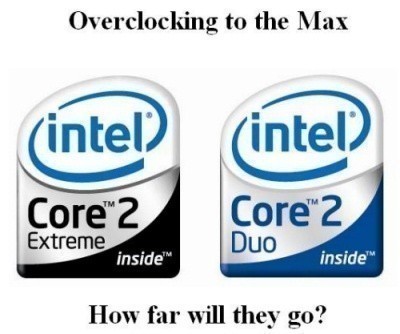
Intel's Core architecture has certainly stirred up the CPU industry. It has been nearly two years that the CPU giant had to take a back seat to AMD in the performance ring. While clock speeds did manage to hit a high of 3.8GHz with their 580 Pentium 4 CPU, it just couldn't beat a Athlon 64 clocked at 2.2Ghz - that's 1.6GHz slower and it still managed to kill the highest clocked Pentium 4 CPU on the market.
Intel still tried to pull as much out of the Netburst Architecture as it possibly could by adding 64-bit extensions, Hyper Treading, and even Dual Core, but all this was simply in a vain attempt to make the Pentium 4 based processors more attractive - suffice to say, it didn't work.
Core Architecture is simply a new start for Intel using what was learnt from the Netburst days, combined with what was more architecturally sound, the Pentium M Architecture, that served the Centrino systems so well.
This has now given birth to the Core series of processors. Currently there are two architectures and four families - Core Solo and Core Duo are based on the first instalment of the Core architecture and are aimed at the laptop sector. In the second generation are the Core 2 Duo and Core 2 Extreme. These are designed for the desktop market and improve on the mobile based Core series.
Recently we took a look at the Core 2 Duo and Core 2 Extreme based processors in terms of the architecture and pitted it against its older Netburst brothers. Today we are going to do something that we didn't get into in our article - Overclocking the processors as far as we can on current readily available motherboards.
We all know how the Pentium 4 overclocks but how well do the Core 2 processors stack up in terms of maximum speed obtainable and it is worth the extra stress on the processor for the extra MHz gain? Today we hope to answer this with our look into overclocking the Intel E6700 and X6800 Extreme processors.
About Core 2 Processors
Before we get into the specifics of the benchmarks let's first take a look at the two contenders for today's overclocking tests. First off we have the flagship of the Intel fleet, the Intel Core 2 Extreme X6800.
Core 2 Extreme processors are set to take the place of the Pentium Extreme Edition.
Core 2 Extreme supports a FSB standard of 266MHz QDR which works out to be 1066MHz. All Core 2 series processors are Dual Core with a shared Level 2 cache which Intel calls Smart Cache. Rather than having separate caches for the two cores, a larger single cache is used for both cores. This allows for both cores to access the same data in L2 cache rather than having to copy the same data onto two separate caches which increases latency and reduces the overall system performance.
Core 2 Extreme and E6700 and E6600 processors all have a 4MB cache. The major features distinguishing the Core 2 Extreme from the Core 2 Duo are firstly a slightly higher core speed and multiplier manipulation. The multiplier manipulation allows you to change CPU rations (only on X6800 Extreme) from as low at 6x all the way to whatever the board will let you go to. While Core 2 Duo allows you to go down to a multiplier of 6x, you can't select any other multipliers other than the CPU default - for example, E6600 is 9 x 266.
Core 2 Duo is the mainstream CPU in the Core architecture. It's set to replace the Pentium D series CPU which will soon be phased out of the Intel line up. Core 2 Duo runs on the same 266MHz QDR bus. Mobile notebook versions of the Core 2 Duo series processors run on a 166MHz QDR bus which gives you 667MHz. The major differenced between the Desktop and Mobile versions are the socket, FSB and energy efficiency ratings. Core 2 Duo come with the same Smart Cache system as the Core 2 Extreme but the sizes vary between 2MB and 4MB depending on the model.
Core 2 Duo series and Core 2 Extreme use the same LGA775 socket that the Pentium Extreme and Pentium D used, however, unless your board has the latest RVM specifications, you're not going to be able to run these processors on your older motherboard.
Intel 975X, P965 series and the upcoming value 946 series chipsets all have the thumbs up from Intel to support Core 2 series CPU. In fact any chipset for Intel that supports the 266MHz FSB can run Core 2 CPU's with the right voltage regulation system.
Soon we'll see nVidia come out with their nForce5 Intel Edition chipset followed about a month later by ATI's RD600 CrossFire Xpress 3200 Intel Edition chipset. Some motherboard companies are still intending on creating motherboards based on this chipset but considering the merger talks between AMD and ATI, it did put a bit of a "hammer in the works" and set things back for this very promising chipset from ATI.
Test System Setup and Overclocking
Test System Setup
Processors: Intel Core 2 Extreme X6800 and E6700 (Supplied by Intel)
Memory: 2x 1GB DDR2-1066 Corsair
Hard Disk: Seagate 7200.9 500GB SATA (Supplied by Seagate)
Graphics Card: nVidia GeForce 7800GT
Motherboard: Gigabyte P965-DQ6 (Supplied by Gigabyte)
Operating System: Microsoft Windows XP Professional SP2
Drivers: Intel INF 8.1.1.1001, nVidia ForceWare 91.31 and DX9c
Here we are going to test the Core 2 Duo E6700 and Core 2 Extreme to their maximum possible overclocking potential using an air cooling solution provided by Gigabyte. We are using the Neon 775 from Gigabyte; however, we have placed a larger and quieter fan onboard as we didn't want the PRM system to run, hence controlling the fan speeds. We wanted the fan to spin at 100% all of the time to prevent premature heating of the heatsink.
We have used the Gigabyte P965-DQ6 motherboard which is based on Intel's P965 chipset - it ranked extremely well in our review when it comes to overclocking (and other aspects), so we decided to use this motherboard for this article.
In our testing we managed to hit with our Core 2 Duo E6700 a maximum speed of 3.37GHz with a 10x multiplier and a FSB of 337MHz with DRAM at 1:1.
Our Core 2 Extreme X6800 processor managed a little better with a speed hitting 3.61GHz using an 11x multiplier and a FSB of 329MHz with DRAM at 1:1.
In our results was have five charts - the processors running at stock speeds, running at their maximum overclocked speed and we have the Core 2 Extreme clocked at 3.37GHz using the same 10x 337Mhz FSB as the Core 2 Duo to show the difference (if any) in the processors at the same clock speeds.
Temperatures you may be wondering about. We are happy to report that the Core 2 Duo at its maximum speed sat at 47 degrees C at idle and topped out at 56 degrees C at full load. Core 2 Extreme sat at 49 degrees C idle and topped out at 59 degrees C under load.
With both processors we raised the core voltages; we set both processors at 1.475v. Settings above this simply aren't advisable on air. Later we might look into extreme cooling with voltage mods but this is a look at what you can expect from overclocking a machine for the average Joe, which is the aim of our article today.
Benchmarks - SiSoft Sandra
SiSoft Sandra
Version and / or Patch Used: 2007
Developer Homepage: http://www.sisoftware.co.uk
Product Homepage: http://sisoftware.jaggedonline.com/index.php?location=home&a=TTA&lang=en
Buy It Here
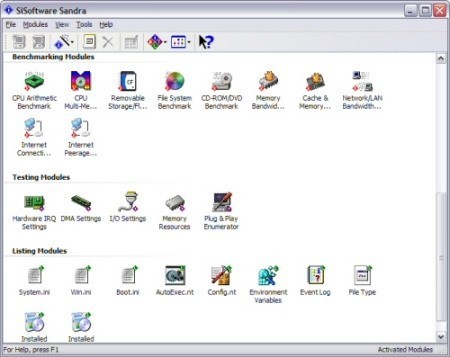
SiSoft Sandra (System ANalyser, Diagnostic and Reporting Assistant) is a synthetic Windows benchmark that features different tests used to evaluate different PC subsystems.
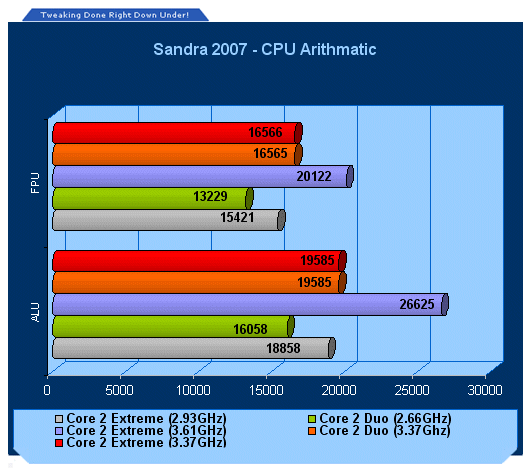
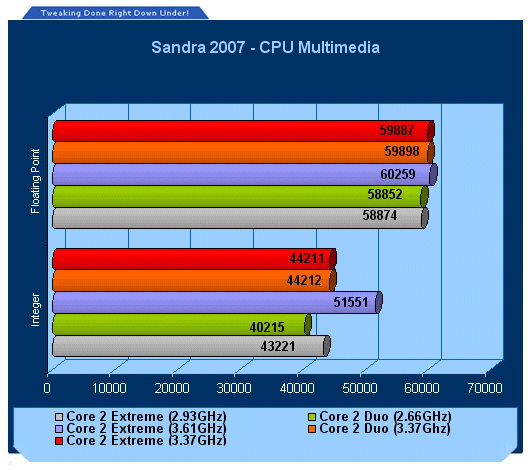
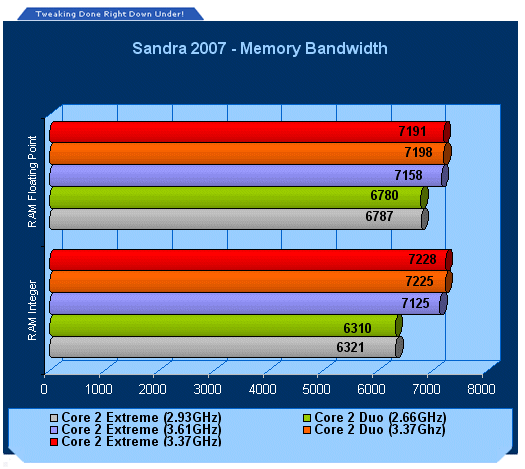
At defaults there are only a few points between the 2 CPU's. At identical clock speeds, the CPU performance between Core 2 Duo and Core 2 Extreme are identical. When at max speed Core 2 Extreme manages to gain some breathing room.
Memory Performance is interesting - at maximum OC speed Core 2 Duo manages to beat the Core 2 Extreme just as it has a slightly higher FSB.
Benchmarks - PCMark05
PCMark
Version and / or Patch Used: 1.1.0
Developer Homepage: http://www.futuremark.com
Product Homepage: http://www.futuremark.com/products/pcmark04/
Buy It Here
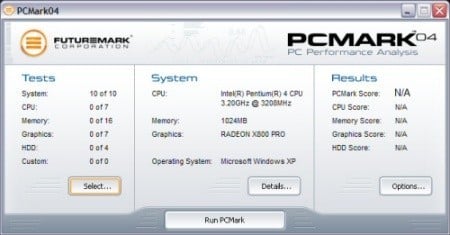
PCMark is a multipurpose benchmark, suited for benchmarking all kinds of PCs, from laptops to workstations, as well as across multiple Windows operating systems. This easy-to-use benchmark makes professional strength benchmarking software available even to novice users. PCMark consists of a series of tests that represent common tasks in home and office programs. PCMark also covers many additional areas outside the scope of other MadOnion.com benchmarks.
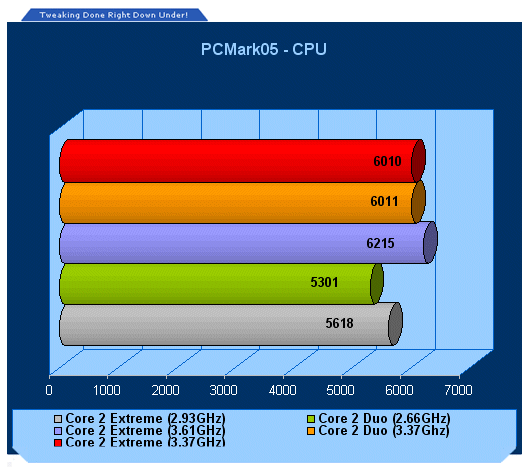
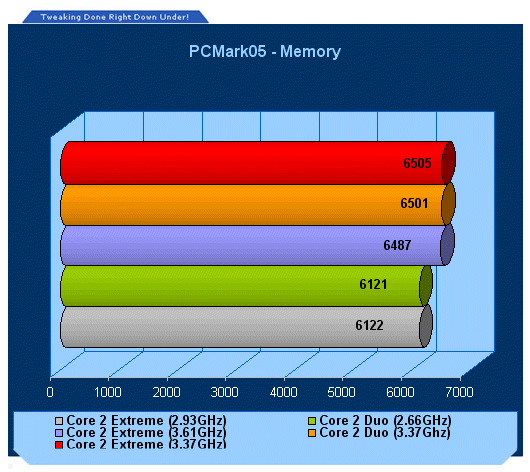
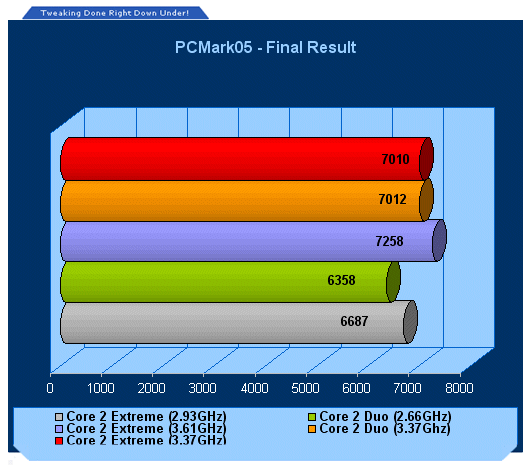
PCMark shows similar trends to the Sandra results.
Benchmarks - Super PI
Super PI
Version and / or Patch Used: 1.1e
Developer Homepage: http://pw1.netcom.com/~hjsmith/Pi/Super_Pi.html
Product Homepage: http://pw1.netcom.com/~hjsmith/Pi/Super_Pi.html
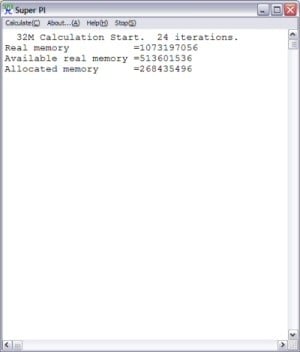
Developed by some folks from the University of Tokyo (yes, Japan), Super PI is a small utility that does just as the name implies. It figures PI to a set number of decimal places. Since PI is an infinite number to the right of the decimal point, the utility measures the time it takes to figure a set number of places. It runs the calculations a set number of times and gives a time for the completion of the task. This is a simple and effective way to measure the raw number crunching power of the processor being used to compile the results.
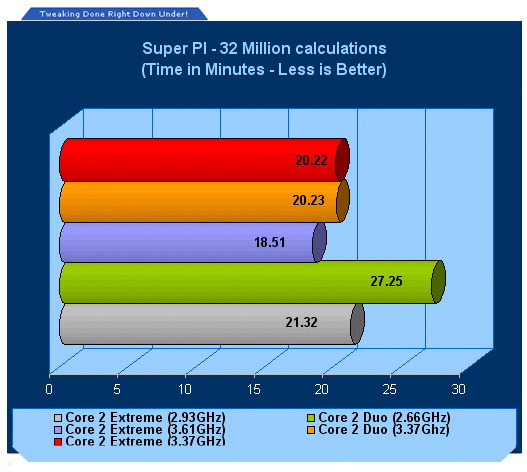
This is where the extra MHz of the Core 2 Extreme manages to show some extra muscle. When you're putting this much stress on the CPU in raw number crunching, extra raw clock speed makes all the difference.
Benchmarks - PI Fast
PI Fast
PiFast is an easy-to-use package written by Xavier Gourdon to compute p with a very large number of digits.
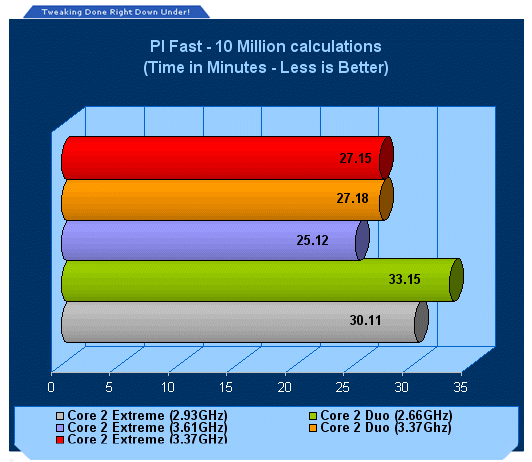
To make sure our Super PI results are confirmed we used Pi Fast which does a similar job to Super Pi.
Benchmarks - Media Encoding
MPEG2 to DivX Encoding with Power Director
Version and / or Patch Used: 5.0
Developer Homepage: http://www.cyberlink.com
Product Homepage: http://www.cyberlink.com/multi/products/main_4_ENU.html
Buy It Here
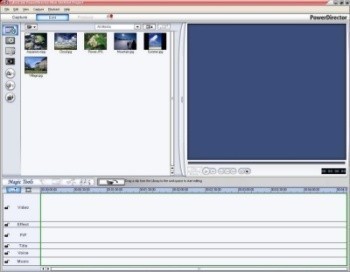
CyberLink Power Director produces video files for creating DVD, DivX, XviD and WMV files for use on your PC. Using the built in software we encode files from MPEG2 (DVD) format to DivX format and use the time taken, average FPS and CPU usage for our benchmarking usage.
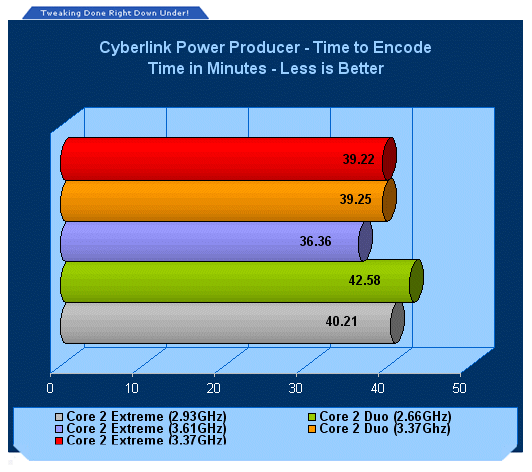
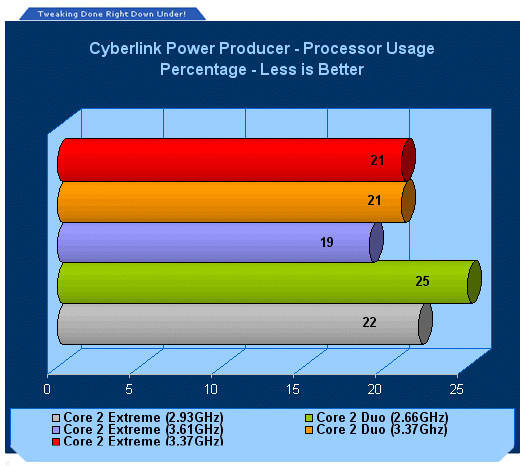
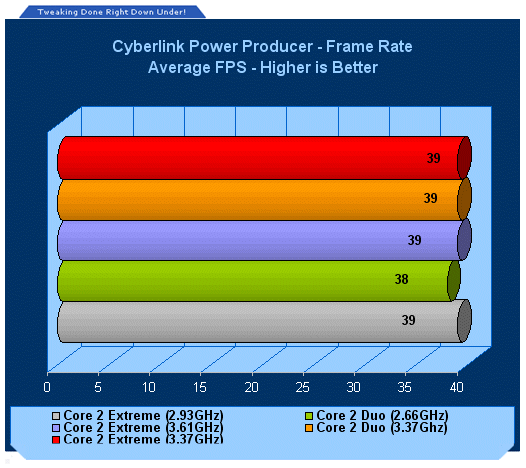
Encoding our MPEG files over to DIVX takes a huge toll on the processor and when the clock speeds go up, encode time and CPU utilisation goes down.
Benchmarks - 3DMark05
3DMark05
Version and / or Patch Used: Build 120
Developer Homepage: http://www.futuremark.com
Product Homepage: http://www.futuremark.com/products/3dmark05/
Buy It Here

3DMark05 is now the second latest version in the popular 3DMark "Gamers Benchmark" series. It includes a complete set of DX9 benchmarks which tests Shader Model 2.0 and above.
For more information on the 3DMark05 benchmark, we recommend you read our preview here.
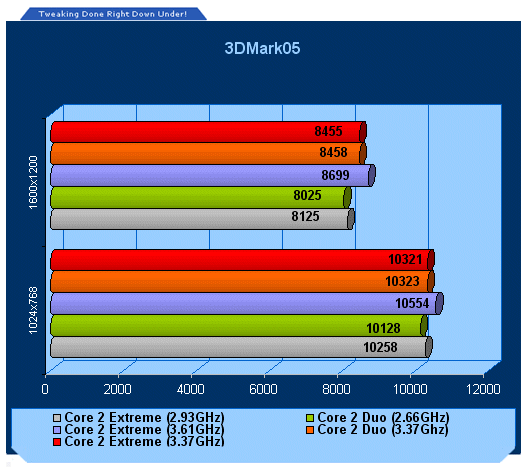
3DMark05 shows us a performance rise when overclocking Core 2 processors.
It is interesting as Core 2 gains more performance in even little steps, where Netburst simply needed 1GHz jumps to notice any real performance gains.
Benchmarks - 3DMark06
3DMark06
Version and / or Patch Used: Build 102
Developer Homepage: http://www.futuremark.com
Product Homepage: http://www.futuremark.com/products/3dmark06/
Buy It Here

3DMark06 is the very latest version of the "Gamers Benchmark" from FutureMark. The newest version of 3DMark expands on the tests in 3DMark05 by adding graphical effects using Shader Model 3.0 and HDR (High Dynamic Range lighting) which will push even the best DX9 graphics cards to the extremes.
3DMark06 also focuses on not just the GPU but the CPU using the AGEIA PhysX software physics library to effectively test single and Dual Core processors.
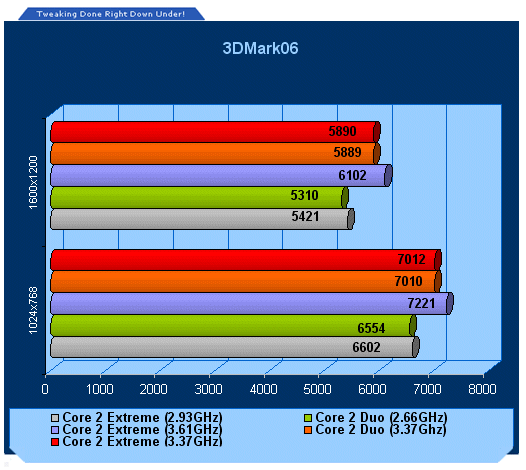
3DMark06 puts more stress on the system than 3Dmark05 and it shows here. When the clock speeds go up, a larger jump in performance is seen than what was observed in the older version.
Benchmarks - Doom 3
Doom 3
Version and / or Patch Used: 1.1
Timedemo or Level Used: Custom Timedemo
Developer Homepage: http://www.idsoftware.com
Product Homepage: http://www.doom3.com
Buy It Here
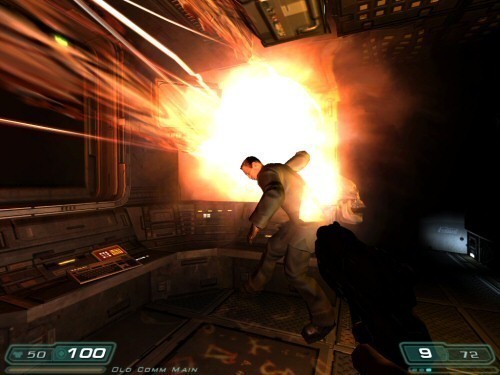
Doom 3 is still one of the most popular games at the moment and is quite intensive in the 3D department, even though it is starting to age. With our own custom time demo we are able to give a realistic rating on what kind of FPS you will be achieving.
For more information on benchmarking Doom 3 we recommend you check out our extensive article regarding it here.
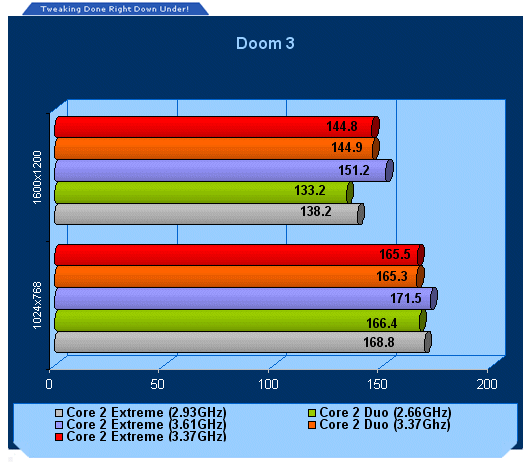
Doom 3 shows us in real world that overclocking the Core 2 is a great way to gain some extra muscle.
Benchmarks - Quake 4
Quake 4
Version and / or Patch Used: Unpatched
Timedemo or Level Used: Custom Timedemo
Developer Homepage: http://www.idsoftware.com
Product Homepage: http://www.quake4game.com
Buy It Here
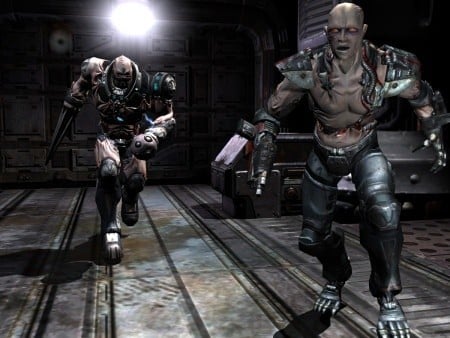
Quake 4 is one of the latest new games to be added to our benchmark suite. It is based off the popular Doom 3 engine and as a result uses many of the features seen in Doom. However, Quake 4 graphics are more intensive than Doom 3 and should put more strain on different parts of the system.
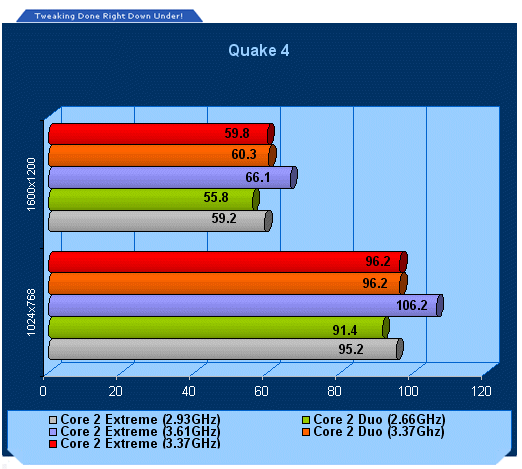
Quake 4 is more stressful than Doom 3 and shows some impressive results on the OC side of things.
Benchmarks - F.E.A.R.
F.E.A.R.
Version and / or Patch Used: Unpatched
Timedemo or Level Used: Custom Timedemo
Developer Homepage: http://www.vugames.com
Product Homepage: http://www.whatisfear.com/us/
Buy It Here
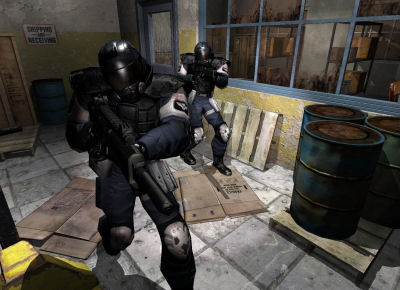
F.E.A.R. (First Encounter Assault Recon) is an intense combat experience with rich atmosphere and a deeply intense paranormal storyline presented entirely in first person. Be the hero in your own spine-tingling epic of action, tension, and terror...and discover the true meaning of F.E.A.R.
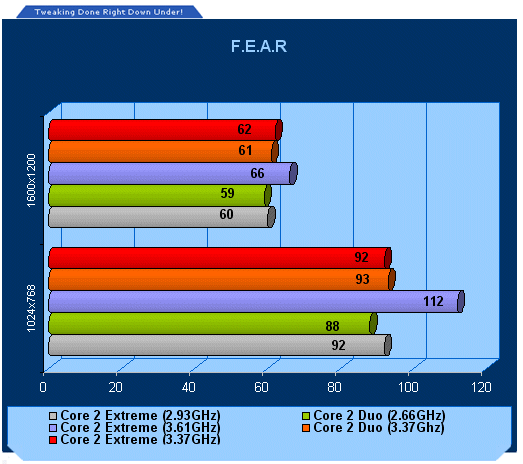
F.E.A.R. relies more on the graphics than the processor, however, with the overclock we do see a few FPS jump.
Benchmarks - Far Cry
Far Cry
Version and / or Patch Used: 1.3
Timedemo or Level Used: Benchemall Default
Developer Homepage: http://www.crytek.com
Product Homepage: http://www.farcrygame.com
Buy It Here

While Far Cry is now one of our older benchmarking games, it is still able to put pressure on most computers systems. Utilizing PS2.0 technology with the latest versions supporting Shader Model 3.0 with DX9c and offering an exceptional visual experience, there is no denying that even some of the faster graphics cards get a bit of a workout.
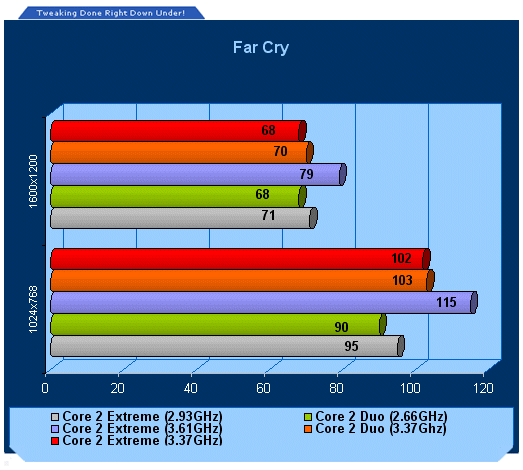
Far Cry depends on processor clock speed to gain performance and here we see what happens in the overclocking section.
Final Thoughts
Overclocking the older Pentium 4 series of processors, especially Prescott, Presler and Ceder Mill based cores was a timely experience resulting in a huge power draw off the PSU and extreme amounts of heat being generated by the processor - either loud air cooling solutions or expensive water cooling rigs were required to keep them operating properly.
Core 2 is simply the answer to all our processor prayers. Not only does Core 2 show a good overclocking curve, even from these early samples we have, but the amount of heat generated per MHz over its default is less than half of what the Pentium 4 generated. Adding to that the reduction in the amount of wattage the processor needs to pull from the PSU to do its job results in a quieter and cooler system.
Core 2 Duo definitely is the more affordable option in the processor realm from Intel and presents good overclocking value. If you want full control over your overclocking which will at the end of the day result in a higher overclock, Core 2 Extreme with its unlocked multipliers, higher starting clocks and higher overclocking ability makes more sense as you can go for a higher bus speed with memory running in a 1:1 ratio to give an overall system boost or simply go for the MHz race and get as much out of the processor to be the king of the hill.

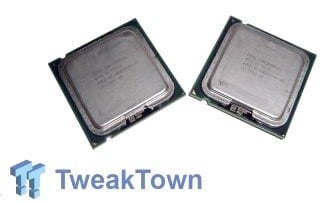
 United
States: Find other tech and computer products like this
over at
United
States: Find other tech and computer products like this
over at  United
Kingdom: Find other tech and computer products like this
over at
United
Kingdom: Find other tech and computer products like this
over at  Australia:
Find other tech and computer products like this over at
Australia:
Find other tech and computer products like this over at  Canada:
Find other tech and computer products like this over at
Canada:
Find other tech and computer products like this over at  Deutschland:
Finde andere Technik- und Computerprodukte wie dieses auf
Deutschland:
Finde andere Technik- und Computerprodukte wie dieses auf